Ultimate Guide to Exercises for Lumbar Herniated Disc Relief 2
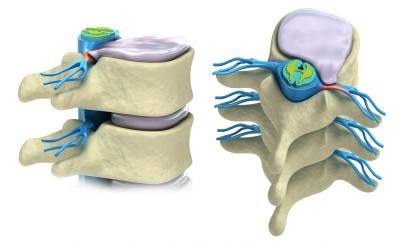
Did you find our previous article, “Disc Herniation Part 1,” helpful but are still battling discomfort? Are you eager to discover exercises that can effectively reposition your herniated disc and enhance your well-being? You’re in the right place.
In this comprehensive guide, we’ll cover:
- Effective Exercises for Repositioning a Herniated Disc: Learn the top movements to gently coax your disc back into alignment, reducing pain and improving mobility.
- Stabilization Techniques to Prevent Disc Displacement: Discover exercises that strengthen your core and back, ensuring your discs stay in place.
Understanding Lumbar Disc Herniation:
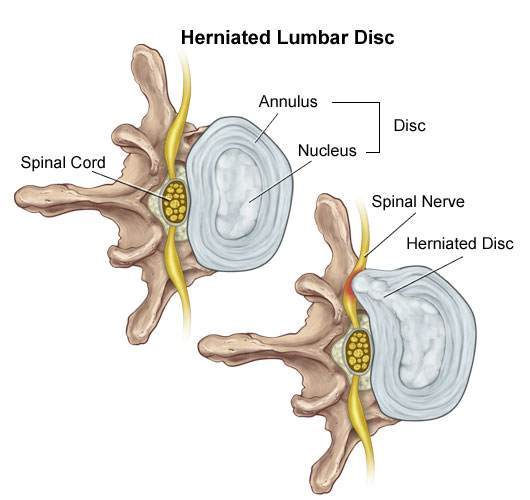
A herniated disc occurs when the disc’s nucleus breaks through the annulus, as shown in the illustration from neurosciences.beaumont.edu. But what triggers this displacement? The primary culprit is forward bending, which compresses the disc (think of it as a jelly-filled doughnut) and can lead to the annulus fracturing, allowing the nucleus to protrude and press against nerves.
Why Does it Hurt?
The disc’s exterior is tough cartilage, while its interior is softer, akin to mucus. Applying pressure on one side forces the inner material to the opposite side, similar to squeezing a doughnut. When a herniated disc or inflammation puts pressure on a nerve, pain ensues. The key to relief is applying counterpressure to reposition the disc.
For a deeper dive into herniated discs, refer to “Disc Herniation Part 1: Best Self-Treatments for Lumbar Disc Herniation.“
How to Apply Counterpressure:
The strategy involves bending your spine backwards or into the extension to shift the disc away from the nerve.
Exercises to Reposition a Herniated Disc: Note of Caution:
Initially, these exercises might intensify your pain slightly. If pain significantly worsens or radiates further down your leg during these exercises, cease immediately and consult a professional.
Exercises for Lumbar Herniated Disc
#1 Prone Lying Lumbar Herniated Disc
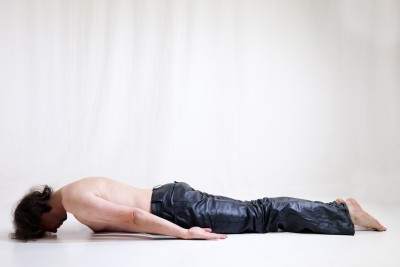
- Lie face down or prone in bed with your elbows tucked in under your side:
- As soon as you get up in the morning you should lie prone (face down). By getting in this position, your lower back becomes more arched, or as doctors say, you increase your lordosis.
- The increased lordosis pushes on the back of the disc helping to bring the nucleus forward into the correct position.
#2 Sphinx pose in Yoga For Lumbar Herniated Disc
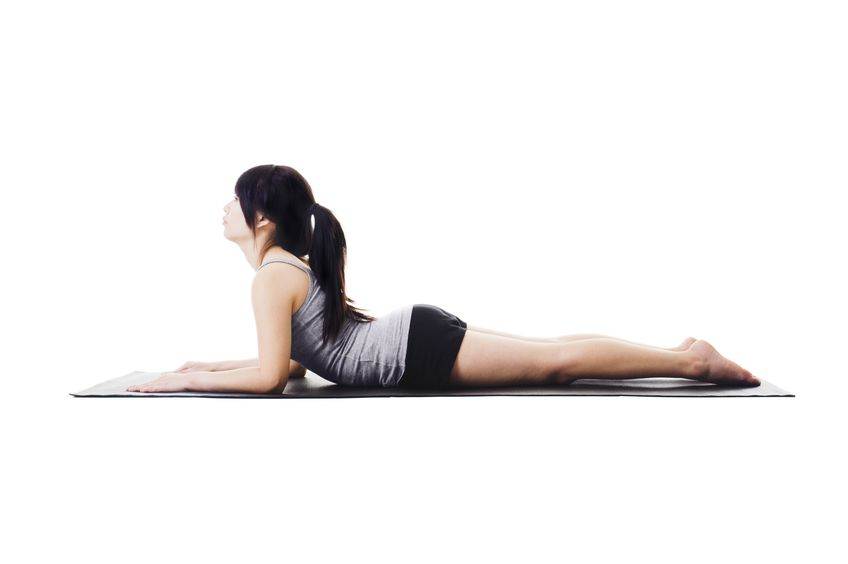
- Get into the prone position lying down on your stomach.
- Next, get on your elbows. If you have a hard time with this position go back into the prone lying position.
- Do these exercises hold each time for 1-2 seconds 6-8 times per set? This exercise can be repeated every two hours throughout the day.
Asses yourself. If the pain has decreased or the pain has moved away from the leg or thigh and into the hip or buttock, this is an improvement. Even if the pain is increased in the back but relieved in the leg this is an improvement and a green light that you should continue this exercise. You also get a green light if there is no difference at all.
- If your self-assessment gives you the green light, move on to the Cobra exercises just below.
- If your thigh or leg pain is worse, then stop right away.
- If your lower back, thighs and legs are the same you get a green light, so move on to the Cobra exercises.
#3 Cobras For Lumbar Herniated Disc
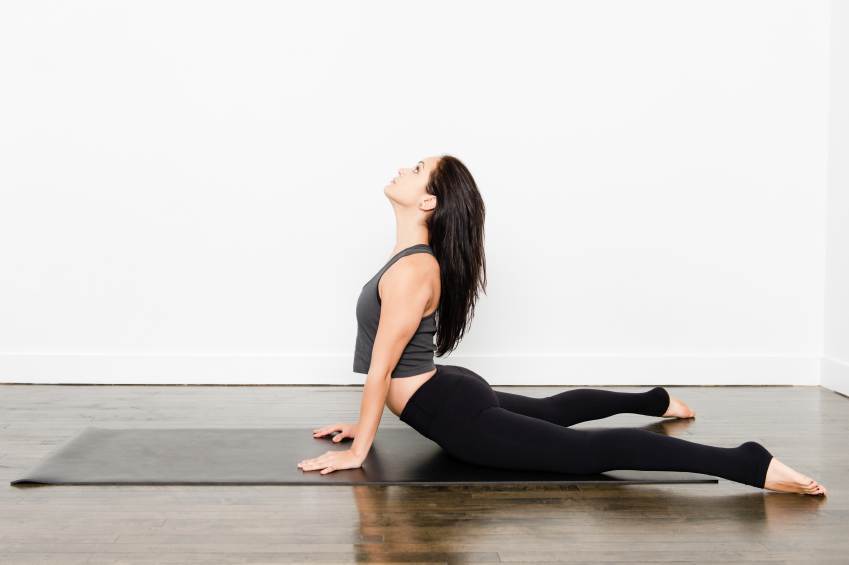
- Lie down face down with your hands underneath your shoulders.
- Push up from as high as you can until your lower back stops you or your elbows are straight.
- The pelvis should still be on the floor and the lower back muscles relaxed.
- Do these exercises hold each time for 1-2 seconds 6-8 times per set? This exercise can be repeated every two hours throughout the day.
Asses yourself. If the pain has decreased or the pain has moved away from the leg or thigh and into the hip or buttock, this is an improvement. Even if the pain is increased in the back but relieved in the leg this is an improvement and a green light that you should continue this exercise. If your thigh or leg pain is worse, then stop right away.
#4 Standing Extensions Lumbar Herniated Disc
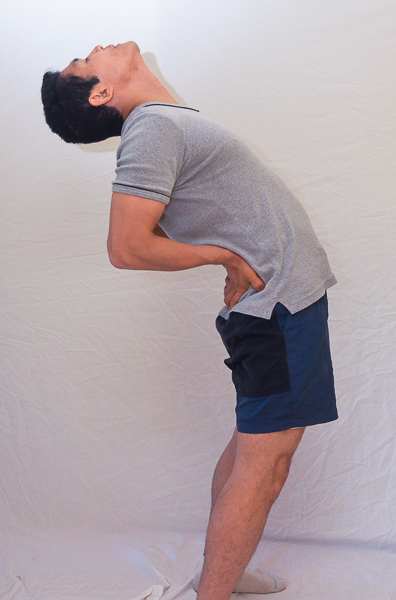
- Stand straight and put your hands behind your hips with your fingers facing down.
- Push your hands into your pelvis so that your lower back arches.
- Don’t use your lower back muscles
- These exercises can be done 6-8 times for 1-2 seconds. This exercise can be repeated every two hours throughout the day.
Stabilization Exercises: Prevent Your Disc From Coming Out By Having A Stable Spine.
#1 Cat-Camel or Cat-Camel For Herniated Disc
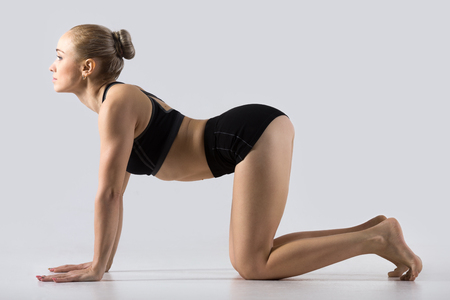
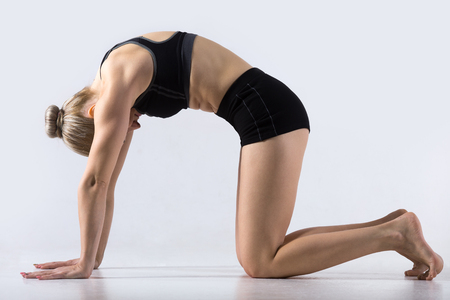
- On all fours with your knees under your hips and hands under your shoulders.
- Inhale and let your belly fall downwards toward the floor as you look up toward the ceiling for 2 seconds.
- Exhale and arch your back up as far as it will go or until you feel pain. You should not feel pain with this exercise, otherwise you are going too high.
- At the same time bend your neck forward and look toward your navel.
#2 Curl-Ups
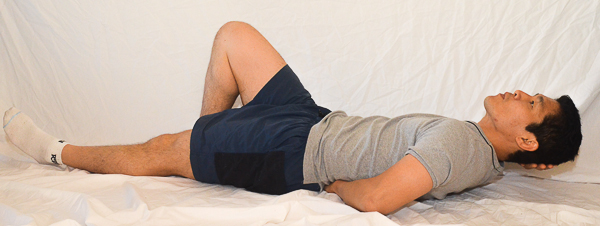
- To start, one foot is bent and the other is straight.
- One forearm goes under the arch of your lower back to support it.
- The other arm is supporting your head.
- Your head and neck come up as one block until your shoulder blades clear the floor.
- Do three sets of 5 working your way up to 10. If it’s easy, then hold for a couple of breaths.
#3 Squats
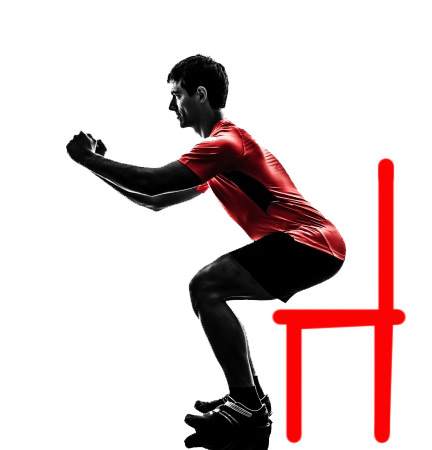
- Stand in front of a chair as if you are going to sit on it.
- Stand with your feet facing slightly more outward than your knee.
- Make sure your butt comes out, and keep lowering your butt until you touch the chair.
- Practice 3 sets of 10.
#4 Bird Dog
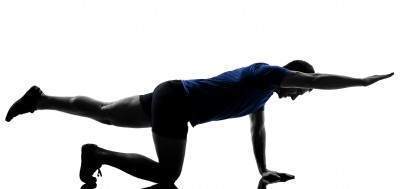
- Get into a crawling position with your hands and feet shoulder-width apart.
- Harden your core by contracting your abs and lower back. This is called bracing.
- Lift your arm first. If this is easy, then lift your leg only. If that is easy, then lift the opposite legs and arms, for example, right leg, and left arm.
- Want to make it tougher? Try lifting an arm and leg on the same side.
- 3 sets of 10. If you are shaking a little or cannot balance quite right, you’re doing the right exercise for you, i.e. lifting just the leg or arm might be easy, but lifting opposite arms and legs might put you off-balance a bit. Make sure you are stable before going to the advanced bird dog.
Tell us what you think in the comments below and like us on Facebook. This Toronto Downtown Chiropractor will answer all questions in the comments section. Let us know your vote for the best Toronto chiropractor in the comments section.
References
1. J Med Genet 2002;39:387-390 doi:10.1136/jmg.39.6.387
Related Categories: Disc Herniation, Elbow, Hip, Low Back Pain, Shoulder

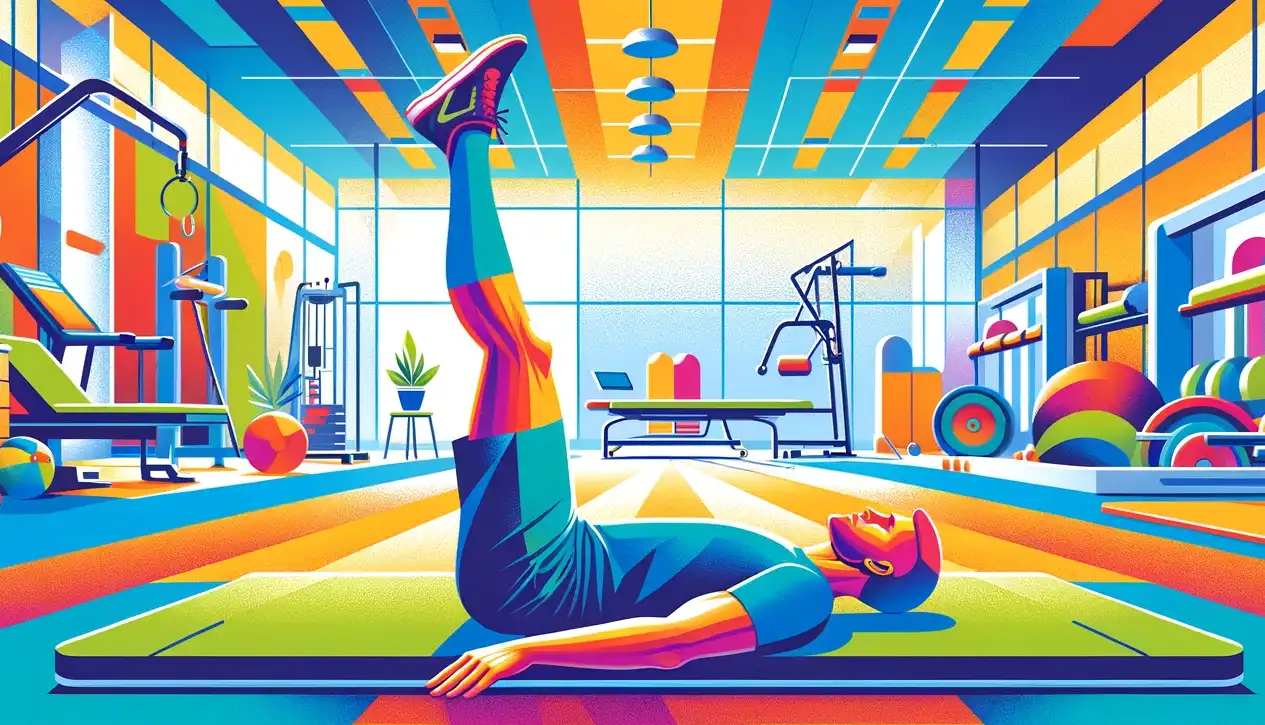


Hello Dr. Nakamura,
Let me just thank you in advance for creating such an informative and helpful website. I had an MRI taken a little over a week ago which revealed that I had a “moderate” herniation in my L4-L5 (6mm), and a “light” herniation in my L5-S1. I have no pain at all in either leg, but did initially experience quite a loss of mobility being unable to bend over to put on my socks and shoes. I started doing the Mckenzie exercises and they seem to have greatly helped (I can do the full “Cobra” extension without any pain or discomfort). Although sleeping has been an issue (not due to pain but rather just not being used to the reccomended positions of sleeping on my back, or the side opposite of my herniated discs), I am not experiencing anywhere near the pain in getting out of bed that I did in the initial first few days. Walking has been really good for me, but I do feel a constant light twinge in my back when I remain standing or seated in the same position too long. Initially, I was deeply depressed at my situation, but now I am beginning to feel somewhat hopeful. If I’ve seen this much improvement in less than two weeks, can I expect a full recovery in the 6 – 8 weeks that is generally mentioned as the period it takes a herniated disc to heal? Will I eventually be able to return to work full-time (my work is physical)? What are the chances of a recurrance? Should I wear a core-support belt, or focus on strengthening those muscles (because I’ve read the belts can weaken them). Also, because I am afraid of twisting in bed, can I wear the belt in my sleep? I have also scheduled an appointment with a neurologist to have him look at my MRI results. Thanking you in advance for whatever information that you can provide me.
Author
Thanks for your comment Ivan. First let me start with your appointment with a neurologist. The good news is you are not a candidate for surgery. Disc herniations which are less than 8 mm do not do well with a type of surgery called discectomy. Also you are getting better with just exercise this also makes you a poor candidate for surgery.
Your recovery will likely be within the 6-8 week range from your history but is by no means guaranteed. Returning to work work is definitely possible if you learn how to lift properly. Look here to learn how to lift properly.https://www.bodiempowerment.com/weight-lifting-techniques-smarter-than-chiropractors-how-to-use-back-safety-lifting-techniques/
Chances of recurrence are high as the disc is never the same. You have to do your exercises before and after strenous activity.
Belts: You should wear a belt if you fit these criteria. https://www.bodiempowerment.com/low-back-support-the-definitive-guide-to-back-supports-and-belts/
You shouldn’t wear the belt in bed. Don’t be afraid. It’s normal to feel pain, pain doesn’t mean you can’t get better.
Hope that helps your herniated disc.
Dear Dr. Nakamura
I came across your site on-line. After reading I developed a good feeling about your site. I was diagnosed with severe loss of L2/L3 disc space. Spondylotic changes of the L-spine. I am now 69 yrs of age. Till last December I have been a very active person. Tried your lumbar exercises for the Herniated Disc. Actually feel much better. Trust I was doing the right thing. Should I continue? Thank you for your help.
Author
Thanks for your comment Helen. Quite often when there is severe wear and tear of the disc AKA osteoarthritis, AKA Degenerative Disc Disease, AKA Spondylosis, there is disc damage. This often leads to disc bulges. So in that light, the herniated disc exercises are helpful for a lot of people with a disc herniation. I would keep doing the exercises until you are better. Some of the exercises except for the cobra can be done on a maintenance basis.
Hope that helps your spondylosis / disc herniation.
Hi Ken, I have moderate disc bulge that causes some numbness and stiff right leg. It also caused some pain couple of weeks back. It has been almost 2 months since it started. I am a Computer Professional. Please suggest me exercises and also advise correct posture to sit and while driving. Currently I dont have any pain but still having that tingling sensation around my back and right butt sometime.
Doctor says clinical tests show negative as while straightening my legs upto almost 70-80 degree , while sleeping on back, apart from some tingling sensation I dont feel any pain. Doctors have advised rest and some pain killers.
Author
Thanks for your comment Biplab. In your case I would do all the exercises in this link except for the nerve flossing. https://www.bodiempowerment.com/sciatica-4-best-exercises/
Hope that helps your disc bulge.
Dear doctor , thanks for helping people , my name is Moauid , i’m having low back pain for 9 months. I used to going to gym and lifting weights for a whole year. I did MRI and it appears that I have a l4-5 central disc protrusion moderate compression to theca sac , and L5-S1 central disc Herniated significant compression to theca sac , and i dont feel pain and numbness in my legs but i feel pain in my low back , I tried to do some physical therapy and it worked for a little while , then the pain increased in my back but i dont know why ! . I saw your suggested exercises and I didn’t feel much pain doing them , my question is : does my herniated disc return to its right place by doing your exercise? . And how long should my recovery take ! , besides can I return to the gym after feeling better or I forget about going to it at all ? Please help
Author
Thanks for your question. You shouldn’t go back to the gym and lift weights until you are recovered. Meanwhile you can do these exercises here in this article.
Also it’s troubling that you say you have a disc protrusion because of an MRI. That’s diagnosis by MRI and not a clinical diagnosis. From what you are telling me you had a different diagnosis and as a result of the MRI your doctor or you think that the diagnosis is a disc protrusion. 60% of 60 year olds with no lower back pain have a disc herniation. What I am saying is your disc herniation may not be the correct diagnosis.
Just because it’s there doesn’t mean that’s the diagnosis.
IF the diagnosis is correct the disc can be pushed back in. Recovery usually is variable and for you will likely take longer as you have had it for 9 months already.
Hope that helps your possible disc protrusion diagnosis.
Hi Dr. Ken,
I had a partial discectomy & spinal fusion performed at the L5 S1 level in April 2012. Now, 2 years later the pain is worse than ever. I try to walk to get in better shape in hopes of alleviating some of my pain. Unfortunately, even a short walk around the block leaves me unable to do so much as stand for the rest of the day. The sciatic pain is unbearable most of the time. I often become “stuck” – for lack of a better way of describing it – when walking or even rolling over in bed. I have tried physical therapy many times, often doing exercises very similar to your recommendations. Unfortunately, based on my past experiences I am almost certain that these exercises will cause me a lot of pain. Do you think it is worth trying to push through the pain & trying these exercises daily? Have you seen cases similar, where a severe herniation was able to be overcome with these exercises? Thanks so much for your feedback!
Author
Thanks for the comment Kaitlyn. Sounds like you have a very severe problem. I’m guessing that the surgery did give you some relief for a period of time. With spinal fusion surgery the disc is taken out to be replaced by bone. You now have 4 lumbar vertebrae instead of 5. This makes a difference in that 4 bones are trying to do the same movement as 5.
The L45 vertebrae takes up more pressure and gets damaged more quickly. You likely had an unhealthy L45 disc previously. (most people have multiple disc damage even though they may not be all bulging).
Having said that there is hope. You can try these exercises for sciatica except for the last exercise the “cobra” https://www.bodiempowerment.com/sciatica-4-best-exercises/
Don’t do the exercises if they give you sharp pain or the exercise gives you progressively increasing pain. If you have more pain for more than 1/2 hour after the exercises than the exercises are not for you.
Hope that helps your disc herniation and sciatica.
Hello Dr ken.
I want to discuss my case as some 5 months ago i had a back pain and after taking some medicines i was ok but after some time i felt that i have a pain in my right buttock.I went to my GP and he referred me to a physio. Physio said you have a muscle spasm in your buttock and you have to do some exercises for stretching the musce. I did those exercises for three months but there was no betterment. Meanwhile i also noticed that i feel pain in my lowerback as well and this pain went down to my ankle. This time i went to another GP and he said i think its heriniated disc. He has arranged an MRI for me which has yet to take place. Gp also said that in worst cast there might be need for a surgery. Four days back i was just googling about heriniated disc and i found your article and i started to do pron pop mcinzie and maknzie push-ups. When i did first day i got 80% relief from leg pain. so there is no pain going down, just a minor one but there is pain in butt. So advice me that for how long i should do these and if you reccoment anything more. Moreover tell me what you think about my case that whether there would be a need for a surgery. I am waiting for your reply DR.
Yours truly
ADIL RAFI.
Author
Thanks for your comment Adil. If your lower back and leg pain is getting better especially 80% better than there is no reason to have surgery at this point in time. Always do conservative therapy first. Surgery cannot be reversed.
Also try the exercises for sciatica. https://www.bodiempowerment.com/sciatica-4-best-exercises/
That should help with your buttock pain.
Hope that helps your disc herniation.
Dear Sir, I am suffering from L4-L5 slip disc causes severe spinal stenosis since pas 5 month, I am little better now. I am trying to perform exercise suggested by you. While doing “prone prop” I start feeling tingling in my left leg. However I could do other exercise without of much pain. I need your advice about the prone prop should I continue with it or stop it. My blood report say vitamin D-3 (12ng/mL) and B12 are deficient and now taking injection for that. Sir how long it will take to cure. Thank You
Mayank
Mumbai
Author
Thanks for your comment Mayank. Disc herniations and spinal stenosis are very different and so need different exercises. In general disc herniations require extension exercises whereas, spinal stenosis requires flexion exercises. (More complicated cases will change this) The prone prop position puts you in extension. You need to do toe touches while standing and while sitting on the floor. Also the hurdler’s stretch would be helpful for you.
Here is the link for the hurdler’s stretch. http://www.exercisegoals.com/hurdlers-stretches.html
The basic idea is that you can’t treat lower back pain like a cook book. You have to diagnose the problem first. Even with the correct diagnosis you need to do the exercises for your diagnosis. Then the exercises should be individualized specifically to you.
Hope that helps your spinal stenosis.
Hello Dr Ken,
I have small left paracentral disk protrusions at T11-12 and L4-5.
Would you suggest any exercises?
My doctor recommended to have steroid twice a year. I had one already. It is help just a little.
I feel not comfortable most of the time.
Thank you.
Author
Thanks for your question Natalya. I would recommend trying the exercises as they will likely be helpful to you. Make sure you read https://www.bodiempowerment.com/disc-herniation-part-1/ to avoid the things that aggravate your spine.
Hope that helps your disc herniation / protrusion.
Thanks for your comment Natalya. You may have a small disc protrusion or hernation when you are lying down in an MRI or CT scan but when you are sitting up, or bending forward you will have more pressure so the disc will stick out more.
Since you already had a steroid injection and it didn’t work I would recommend against it. I also wonder why your doctor is not recommending any exercises for your disc protrusions.
Research has found that exercises for disc herniations and protrusions are actually quite helpful. I would do all the exercises listed above.
If the exercises are not helpful the diagnosis is likely wrong. What you see on MRI is not always the diagnosis. Again from the research normal people with no pain in the their lower back have full blown disc herniations. A thorough examination by your a doctor or another doctor including a neurological examination is essential.
Hi, very useful website, just a few questions…after going to A&E with the excruciating pain about 16 months ago (pain had gradually built up over a couple of weeks), I had MRI and diagnosed prolapsed disc in lumbar.. lots of expensive and cheap drugs and a few months it gradually cleared up. I’ve been doing yoga, snowboarding, running since, had the occasional stiffness, but it suddenly returned (with pains down one leg etc.) after coming back from a long hot holiday to the relative cold (uk) and back to stressful work (also badly sprained my ankle just before returning home). I sit at my desk for 10hrs a day (can you recommend a type of chair? or just don’t sit for too long?)
Main question is: Would you suggest seeing a chiropractor? It seems your advice is to not risk seeing a bad one, and rather do the exercises? Wondering whether I can benefit from being cracked around on the chiro table or should I steer clear? Also, what about other general massage etc.? I have all the scans on disk that I could show anyone before they got to work on me…… many thanks
Author
Thanks for the comment Declan. You are right the cold from the UK can get into your back. I know cause I lived near Norwich for a couple of years.
As for the sitting. Most chairs don’t have the proper lower back support. If your chair doesn’t than you can roll up a small bath towel and use masking /gaffer tape on each side to keep the towel in rolled up position. The rolled towel should be about the size of your forearm or larger depending on how large your low back curve or lumbar lordosis is. Put the towel at the deepest part of your curve and sit down with your spine right up against the chair. Use your whole back rest. If that helps you you can buy a lumbar support roll. Also don’t sit for more than one hour.
For sciatica (pain down the leg) you can do these exercises and the disc herniation exercises. If that doesn’t help you should see a chiropractor.
https://www.bodiempowerment.com/chiropractic-clinic-questions-chiropractic-clinic-best-practices/
If you are thinking about seeing a chiropractor here are two articles to consider. Having worked as a chiropractor in the UK everything in the articles applies.
https://www.bodiempowerment.com/best-toronto-chiropractor-find-best-chiropractor-city/
https://www.bodiempowerment.com/chiropractic-clinic-questions-chiropractic-clinic-best-practices/
Ok thx dr ken so im getting the injection of cortisone in 1 week in the mean time if exercise hurt and the herniation is big is the best way to sit stil and not move til the injection?
Author
Steve you should move from sitting to standing to laying down. Don’t stay in one position too long. Don’t do the exercises as even lying face down (prone) give you pain. This means that the disc herniation is too big to give you any help with exercises. You also may want to talk to your doctor about the different types of injections as there are many types.
My experience is that cortisone is very much a hit and miss. (this is what patients tell me not according to the research).
Hope that helps your disc herniation.
Ok thx very much and ya i know about other injection but they are 8 months delay
Author
I hope that you get better soon Steve.
Good morning Dr. Ken.
I came across your website looking up exercises for a herniated cervical disc between C4-C5. It was diagnosed last June and even though I went through PT and Epidurals I’m still having pain in both my neck and radiating down my arms. I was wondering if these exercises would be helpful for that? If not can you suggest anything that would? Also, would swimming be beneficial? I’m trying to get back to playing golf 🙂 Thank you so much for the help you’ve provided to so many people. Thanks!
Author
Thanks for your comment. These are lumbar disc herniation exercises so, would definitely not be helpful for your case. The pain radiating down both arms tells me you have a very large central disc herniation. A nerve root block or injection may be helpful in your case but you should consult your family doctor about this. The problem is if you go directly to a “pain specialist” they have a financial interest in saying it will help.
Try reading this article. https://www.bodiempowerment.com/chiropractic-manipulation-vs-nerve-injections/
Hi dr ken i have 2 herniated disc L4L5 that is the small one and L3L4 doctors say is very big herniation im only 24 yrs old these exercise where given to me by a physiotherapiste but they cause me more pain when i do them even the prone lying face down position what type of exercise shud i do since these cause pain? Thx
Author
Thanks for your comment Steve. When you have a very large disc herniation it is usually not appropriate to do the exercise as it will pinch the disc and make the situation worse. You have will to consider injections or surgery.
You should read the following article.
https://www.bodiempowerment.com/chiropractic-manipulation-vs-nerve-injections/
Hi I’m seeing a surgeon on Monday to talk about options… My MRI shows 17mm bulge at l5s1. Do you think surgery is avoidable? Thanks in advance
Author
Thanks for your comment Phil. You have to consider three things.
1. AN MRI will show discs very well but we know from the research that people with no low back pain or sciatica have full blown disc herniations. So the question is your disc herniation causing your pain? Make sure the surgeon did a thorough examination including a neurological examination. A diagnosis for disc hernniation is based on clinical examinations in the office not on a MRI. (many normal people have disc hernations) https://www.bodiempowerment.com/mri-ct-scan-x-rays/
2. The US department of Health and Human Services did a study and said that the increasing rates of US spinal fusion surgeries are likely driven by financial incentives. https://www.bodiempowerment.com/beware-surgery-low-back-pain/ This is a must read for you.
3. Did you get a second and third opinion. Due to the financial incentives in the USA it is better to get a opinion from a person unaffiliated with the surgeon like your family doctor, chiropractor or physiotherapist. However if you have one of the following surgery would likely be helpful.
Spinal Fracture – Some types of fractures can be left alone as they cause little to no pain while others fractures are painful or can potentially cause paralysis
Infection of your spine- Surgery is still last resort after antibiotics.
Disc Herniations in which conservative treatment was not helpful
Severe Degenerative Disc Disease which has not responded to conservative care
Spinal Stenosis /Lateral Stenosis that has not responded to conservative care
Spondylolisthesis: Foward slippage of one vertebrae which has not responded to conservative care.
Scoliosis: which has not responded to conservative care
I would read both links to the articles thoroughly.
Hope that helps your possible disc herniation / bulge.
Hi! Is vibration machine safe to use by people with back problems like me? I have mild L1/ L2 lumbar canal stenosis secondary to a focal left L1/ L2 disc prolapse. ? left sided cord or nerve infringement, mild L4/ L5 and L5/ S1 lumbar canal stenosis secondary to a central disc prolapse at both levels and a moderately severe bilateral L1/ L2 and mild to moderate bilateral L4/ L5 and bilateral L4/L5 and bilateral L5/ S1 facet joint arthritis. Reading your articles gave me hope in my condition. Please help!
Author
Thanks for your comment Annie. Vibration has been shown to increase risk of lower back problems especially if you are sitting. Usually from vehicles that vibrate. Vibration from hand held “massage” machines that you do for 10 minutes is less likely to cause problems in my opinion (I haven’t any good studies).
Hope that helps.
Hi Dr Ken,
I’m having a lot of issues with back pain and have for quite some time. I play contact sports and am very fit and have a strong core. All of the above exercises I have done for months without any real improvement. I can’t bend over at all until I spend 20-30 mins of warm up. Is there anything else you can recommend ?
Author
Thanks for your comment Brendon. There are two questions and three comments.
1. The first question is do you have a disc herniation? Sometimes doctors will diagnose a problem based on MRI, CT scan, or X-rays eg. 30% of 30 year old without any pain have disc herniations. So if a person with no pain has a disc herniation it doesn’t mean what you see on MRI/CAT scan is your diagnosis. Some doctors do a neurological exam but others don’t. A neurological examination is one of the keys to making a diagnosis of disc herniation. If you are doing the exercises and you have a different diagnosis the exercises will not help.
2. What other core exercises are you doing? Many core exercises aggravate herniated discs. Core exercises for their lower back like sit-ups, crunches, leg raises, leg raises with exercise ball ….. will make your lower back worse. There are many more. I would stop all other core exercises if you want the exercises to help.
3. The exercises are meant as general exercises for disc herniation not specifically for more complex cases. eg. most people have a disc herniation that comes out the back and slightly to the side vs. the front. If your disc herniation is unusual and coming out the front or purely the side the exercises will not help you. If that is the case you would be in a more unusual case. If you have one of these cases let me know and I will suggest an exercise.
4. You should try to avoid the things that aggravate a lumbar disc herniation. Most people aggravate their herniated disc many times throughout the day so this article is a must for you. https://www.bodiempowerment.com/disc-herniation-part-1/
5. You don’t say what your sports are but sports like Hockey, Rugby, Football etc… especially contact sports will aggravate your lower back. Even if the exercises are helping you may be setting yourself backwards again. Swimming and cycling in a upright posture with your lower back arch intact won’t aggravate your lower back.
respected sir,ihave central disc protusion at l5 s1 since 9 months and am doing back strengthning exercises daily ,but there is pain in lower back and numbness in right groin up to the 1st toe………….wat can i do sir………..is cat-cow and curl ups can i do..is it ok for me…..please help me sir
Author
Thanks for the your comment Gangadhar. When you have pain in the groin that is red flag. What I mean it that your bowl and bladder function should be looked at by a health professional such as a chiropractor or medical doctor. Also if the groin pain is new and you are getting worse this is yellow flag. I am sorry in your case the exercises are not for you at this time until you improve a little bit more.
Hope that answers your question about your disc herniations.
Dr.ken,
I have started both ankle and lower back exercises. One more problem I am facing since my ankle injury is that when I stand for a while I can’t keep my right leg straight(injured side), my ankle will feel a tightness and burning sensation and so I have keep right leg slightly bent. Will this also be cured with the ankle exercise?
Both my back pain and ankle pain are only in the right side. Thanks in advance for your time.
Regards
DK
Author
Thanks for your question DK. Your case is a little more complex than just a herniated disc but you should be able to deal by dealing with the calf muscle. Try lying on your back and using both hands put your thumbs on the top part of your calf you will likely find that the calf muscle is very tight. Loosen up all the muscles that are tight.
Dear Doctor,
I was having severe pain at my lower lumbar region which further shifted to left buttock and through the legs. Also I had a feeling of numbness in my feet. last December I was admitted to the hospital with this symptoms. On Examination my legs showed weakness also. MRI was done and I was diagnosed with a slipped disc. I was given medicines, injections and was discharged after five days. Since then I have been taking medicines. I was ok but lately my pain has increased so much. Is these exercise ok for me?
Author
Thanks for your story David. You will have to try starting with the gentler exercises. The rule is that if you get sharp pain the exercise is not for you at the present time. If you get an ache after the exercise that lasts more than 10 minutes you have gone too hard. For you lying face down (prone) and the sphinx exercise for your herniated disc should be fine, but I can’t predict for your as I haven’t examined you. Start with those and as you gain confidence you can move onto the other exercises.
There is also the sciatica exercises here https://www.bodiempowerment.com/low-back-pain/sciatica-4-best-exercises/ which should give you a little more variety.
Hope that helps your herniated disc.
Hi Dr.Ken,
Your article is very informative. i am 30 years old and I think that I have injured my lower disc as well due to my routine lifestyle. However I have started doing the recommended exercise and feeling the recovery. My question is I am used for regular joggings, restricting that making me feel sick. Would like to know whether I can start jogging again? Thanks for your advise.
Regards
DK
Author
Thanks for participating DK. Disc herniations can be tricky and take time to recover, so I am very happy that you are starting to feel a little better.
You need to be able to first walk with no pain and be able to extend (bend backwards with your lower back while standing) your spine. When you are running or jogging you are basically extending your spine with the added pressure from going up and down. So if you extend your spine fully (as far as you can go) and feel pain down the leg you shouldn’t run. If you extend the spine fully and feel pain mild pain in your lower back at the end of the movement you are likely fine to go jogging. However if the pain lasts more than a few seconds you are not ready.
Hope that helps.
Hi Dr.ken, thank you very much for the reply and I am so glad that I came across your website. I will check myself as per your advise but I have another question.I am having a slight burning sensation and slight pain near my ankle for the last 1 year since I sprained my ankle twice last year(but I didn’t stop jogging). The back pain is only for last couple of months. So should I not jog until I have this ankle pain? Any advise to get rid of this ankle pain and burning sensation?
Thanks
DK
Author
Dinesh,
If you can still jog while with your sprained ankle than you have a 2nd degree ankle sprain. You can still job but keep in my that you have a good chance of spraining it again if you did not rehabilitate it properly. You will have to determine if it is worth the risk.
You need stability and strength around your ankle joint. I will describe two exercises.
1. Heel Raises. Stand with both feet shoulder width apart and go up on your toes slowly and go right down till your heels touch. Try not rest if you can. Do this 20 times for 3 sets. ie 60 times. When you are stronger do this on one foot. Warning: Make sure you are within arms length of a table or chair that you can lean on if you lose your balance.
2. Stand on one leg (the side with the bad ankle). Move your other leg back and forth and sideways. This will make your ankle work hard to keep the balance. Start with small movements and use larger movements as you get better. Warning: Make sure you are near a table or chair that you can hang on to if you lose your balance.
Thank you very much doctor. Will do exercise for both my back and ankle and will restrain myself from jogging for one month to two month.
Regards
Dk
Author
You are welcome Dinesh. I hope you find yourself jogging soon. Meanwhile keep up your fitness by swimming, cycling or speed walking.
Dr. Ken
I was told I had disc hernias in my upper/middle back. They cause tremendous amounts of pain for me. They have checked my movements & state I have a 7% person disability due to that, as well as a protrusion on my right knee cap. What would be recommended for exercise & what would be not recommended? Thanks.
Author
Thanks for your comment Tawnya. Mid and upper back disc herniations can be very painful. They are not very common so you might want a second opinion. The reason is what you see is not always what the diagnosis is. Disc herniations are notorious for this. The following article explains how normal people with no pain have disc herniations. https://www.bodiempowerment.com/mri-ct-scan-x-rays/ So if you have pain and a disc herniation on MRI it doesn’t mean that the is the reason for your pain. The MRI needs to match your history and neurological exam results. Otherwise its a best guess. Doctors and chiropractors call a best guess a differential diagnosis.
Providing that the mid / upper back disc herniation or thoracic disc herniation is correct you can do all the exercises show in this article with the exception of one. The Cat-cow. Cats arch their backs up when they are scared. Arching your back like a cat will aggravate most people who have a disc herniation in the thoracic spine unless it is mild. So just stay away from the cat part of the cat-cow exercise.
Hope that helps. If you have any more questions regarding anything feel free to ask more questions.
Dear Dr. Ken,
My wife having a herniated disc and the pain goes to the leg also. I want to know if she having this pain can she do this exercises. Waiting for reapply.
Thank you
Author
Thanks for your inquiry Jevon. The quick answer is yes but there are things to consider. These exercises are designed for the general person with disc herniation and not specifically for your spouse’s case. Also the person that diagnosed the problem may or may not have diagnosed the problem properly. For example a disc herniation, lateral stenosis (narrowing of the opening for the nerve), spondyloisthesis (fracture or wear & tear leading a break) and piriformis syndrome (muscle spasm) and claudication (sciatica that prevents you from walking) are all similar to disc herniation but have different treatments. So if your spouse was not diagnosed properly then doing these exercises may help somewhat or not help at all. In the case of claudication they can cause aggravation of the problem while in all the cases they will not likely do any harm.
In summary the right diagnosis is needed. While doing the exercises if she feels sharp pain stop right away. If she feels worse after the exercise for more than an hour she went to hard or the exercise is not for her. The disc herniation exercises are designed to help most cases but they may not help hers as each case is unique.
You should read the sciatica article to help you differentiate between the different types of sciatica and determine if your health care practitioner is on track. https://www.bodiempowerment.com/low-back-pain/sciatica-4-best-exercises/
Another common pit falls among medical doctors is to say you have a disc herniation just because its on the MRI without doing a full neurological examination. Study after study shows that normal people with no pain have disc bulges, prolapses and disc hernations. The questions you need to ask are: Did your doctor check your reflexes, muscle testing like heel raises, and walking on heels and check your light touch and sharp/dull sensitivity on your foot. If they didn’t and sent you for X-rays and MRI this is a sign of a doctor diagnosing based on images and not based on key history and examination findings. This is Key. For more information on this read this article. https://www.bodiempowerment.com/mri-ct-scan-x-rays/
Hope that helps.
I also suffer from herniated disk, it is a year and half now. In the beginning I was not able to sit at all, not even in washroom. I could not feel my leg from knee down, there was only complete numbness, cold and constant pain. I could not even lift leg of the ground. I have seen neurosurgeon after 5 months and by that time doing different researches I was getting bit better and even went back to work part time (sitting job). In his opinion that was good sign and he said I should continue doing everything I was doing at that point and will get better.
Now I am back full time to work, but my life is still so limited. Even small change in weather or temperature aggravates me a lot. Even getting in air conditioned room gets mu muscles contracted and stiff and pain starts. If the chair is not proper I hurt. I can only drive van no car where my knees are higher than my hips. Shoes are my nightmare. When it is humid I am in pain, whole winter I was wearing wool long johns, and that have saved me. Very often I wake up in screaming cramps in my calf mostly but also in my thigh. My doctor does not care a lot, he is a suborn men and even me going to physio therapist and massage therapist was my idea not his. Every time I ask for opinion or some help he tells me I can go to neurosurgeon again but I should be prepared and ready to accept surgery. I am getting tired and discouraged even with things I was so diligent about. What else is there to try, and how long should I be looking for answers. I don t see improvement any more and I don t know what else is there to try or how long should it take for me to get better now. I know this is a very long post but I really need some more ideas and input. My physio helps to relive stiffness but not for long, Massage therapy same. They both are not sure why I cramp or get so tight and stiff.
Author
Thanks for your question Nea. The good news is that some of the herniation that is sticking out simply gets dissolved or reabsorbed within a year. You can benefit further by trying these exercises in the link below.
You must read the instructions carefully as you may aggravate your condition further. Basically as long your nerve is not stuck (tethered) to other parts of the nerve flossing exercise and others may be highly beneficial for you.
https://www.bodiempowerment.com/sciatica-4-best-exercises/
If that does’t help and your disc is still sticking out more than 8mm you should consider discectomy surgery.
Hope that helps your disc herniation.
I don’t know if you are fine now. I had very similar pain. I think you should go for the surgery and it is not as bad as it sounds. I had disc herniations multiple times (more than 4) and every time it took 6 months to go away. Over the years it had calcified and not completely retracted. This time I had too much pain and got MRI done and doctor suggested operation. It has been one month after the micro discectomy. I have no back pain and able to do most of the work I used to. I am taking it slow as doctor has suggested me not to overdo anything.
1. Reduced height and right posterior para central herniation of nucleus pulposis of C4-C5 intervertebral disc.
2. Central posterior protrusion of C5-6 intervertebral Disc resulting into compression of thecal sac, lateral recesses and existing nerve root. Multi level osteophyte formation.
3.Diffuse Posterior bulge of C3-4 intervertebral Disc
4. Poor signal reversal of nuclei pulposes of all cervical Invertebral discs seen. Please suggest home remedies and exercises…………some medicine OTC ………..will be much obliged
Author
Thanks for your comment Imtiaz. You can try doing some chin tucks. http://naturalsundquist.wordpress.com/2014/03/02/lose-fat-gain-muscle/ Just scroll down to the picture of a person viewed from the side.
If those are OK you can try doing some neck extension but they may aggravate your neck as the disc is sticking out too much. An easy way to tell is if you slowly bend your neck backwards until you feel pain. If it causes numbness, tingling or pain going down the shoulder or arm than it is too much. If it just causes just soreness than you can do some extension exercises.
https://www.bodiempowerment.com/3-exercises-for-cervical-spine-pain/
With these exercises if you get sharp pain, increasing pain while doing the exercises or if you are more sore than 1/2 hour after doing the exercises than the exercises are not for you.
Hope that helps your neck disc herniation.
Thanked for you helping people .
I am zaina , 38 years old femal , I have l5 s1 disc From 22/1 I have pain and I cold not move at first time but after 3week I am fine I cold move walk but I wont to lose weight my weight 86 my hight 160
Plz help me plz.
Author
Thanks for your question Zaina. You don’t give me a lot of information so I will have to assume that you have a regular type of disc herniation and also that your diagnosis is correct. If that is the case than these exercises should help you.
You should stop the exercises if the exercises give you increased pain or pain further down the leg.
Hope that helps your disc herniation.
My wife has pain in leg hip and foot. MRI report as below
1 posterior bulging of l5-l4 intervertebral disc without compressive element.
2 posterior and left para central herniation of l5-s1 intervertebral disc causing mild compression left ventral theca and left side descending nerve roots.
dr.said for surgery please help me & suggest me surgery is compulsory or any other treatments or exercises can recover it.
Thanks a lot
ravi
Author
Thanks for your question Ravindra. First you don’t know if the disc is the cause of your pain. Also if you didn’t do conservative therapy like exercises, chiropractic or physical therapy then something is wrong. You always do conservative care followed by injections and as a last resort surgery. I would try several different practitioners. I would also get a second or third opinion. From the limited amount of information the recommendation you have received not sound.
Also disc surgery is not often successful if the disc is not sticking out more than 8mm. Indications for surgery are if you have bowel and bladder problems, deteriorating muscle nerve problems and failure of conservative therapy.
Hope that helps your possible disc herniation.
I have been suffering with leg pain now for about 6 months. Burning down front and side of leg. I have done physical therapy with some results but pain returns. The MRI states the following:
L2-L3 disc is midly narrowed, demonstrates mild desiccation and a large broad based right posterolateral/neural foraminal disc herniation. Measures 5x23x15mm in oblique Ap,transverse and craniocaudal dimensions respectively. It results in narrowing of the right lateral recess and the right neural foramen. No significant stenosis is seen. Left foramen patent. My question is do you thing this could still self dissolve or do I need surgery to correct. I do Mckenzie therapy 3 times a day for the last 2 months. Value your opinion, hope to hear from you so.
Author
Thanks for question Shanna. After 6 months many people’s disc does dissolve but unfortunately not enough for some. If you are not improving doing these exercises will be not enough. You need to see a health professional.
Hope that helps your disc herniation.
Good morning dr Ken I am Dr mohamed Adam I work in ICU, I have been experiencing back ache for more than two years especially while driving my car, I had to go to the emergency and had an MRI, it showed a posterior large herniaition, there is no sciatica or weakness nor loss of bladder or bowl functions, I met the spinal surgeon who referee me to neurosurgery who replied no surgical intervention needed at present I am on Celebrex now and started mobilizing around my weight is 94 kg height 185cm starred in a diet, I used to go out cycling once weekly, what exercise can benefit my condition and can I go using my bike
Author
Thanks for your question Dr Mohamed. Likely cycling would aggravate you. I would recommend against it. Also when riding in your car I would get a lumbar support roll. You can start by rolling up a towel and tying both ends or taping both ends. The rolled up towel should be a little bigger than your forearm. That will help keep your from getting as much lower back pain while driving.
Also try the exercises in this article.
Hope that helps your large disc herniation.
Hello, i recently herniated my lumbar disks and ive been undergoing therapy which has helped alot, yet ive had weakness in my right leg since my original injury. Should i continue therapy and see if it improves or visit a doctor. Ive been going to therapy for the past 2 weeks. Thanks
Author
Thanks for your question Xavier. You need to be patient as getting your strength back can take many weeks or months.
Hope that helps your possible disc herniation.
sir i am suffering from disc bluging problem since two year i had done mri report it it c2 to c7 disc bluging &disc dicication with all parametors .it is pain and iritated my life ..without operation how can i revocery .please suggest me ur a god in my life please sir……….please send me ur mobile number through mail.
Author
Thanks for your question SUDHAKAR. You need to tell me a lot more. How about your symptoms. Describe them. Otherwise I can’t comment as it would not by right to do so.
This is my report of shilpa
Suble bulge in L4-L5 and L5-S6. Levels
nerve root impingement
Comments …..Incidental tiny 7-8mm perineuralcyst noted at S1 level at right side
I am having severe pain in my toe beneath and legs from 3 years….please help me out
Our doctor has said surgery is only option
Author
Thanks for your question Shilpa. A MRI sometimes shows the cause of the pain, many times it doesn’t. For example 30% of 30 years that have NO BACK PAIN have disc herniations. So your nerve root impingement or MRI doesn’t mean it’s causing your pain. This is proven over and over with research.
I can only give you a suggestion if you tell me about your problem is.
Hope that helps your herniated disc.
What a great article. I am a 56 year old recreational runner who has just been diagnosed with a femoral neuralgia from a bulging disc. I am Ina lot of pain and am doing the exercise you recommend which does improve/ stop the hip and quad pain but only for a short time. As soon as I sit or lie down it comes back. Do you have any advice for sitting and sleeping ? And if this is mild to moderate how long can I expect to be in pain. Does the disc gel actually go back in and stay there ?
Author
Thanks for your question Janice. You should try to keep the curve in your lower back. The best way to do that is to get a lumbar support roll. Place the lumbar support roll at the back of your chair just like a back support for the chair. It should be a the most curved part of your lower back if you look in the mirror from the side.
As for sleeping positions, usually you can sleep on your side with your leg behind your back as opposed to in front in the fetal position. So the opposite of the fetal position.
Hope that helps.